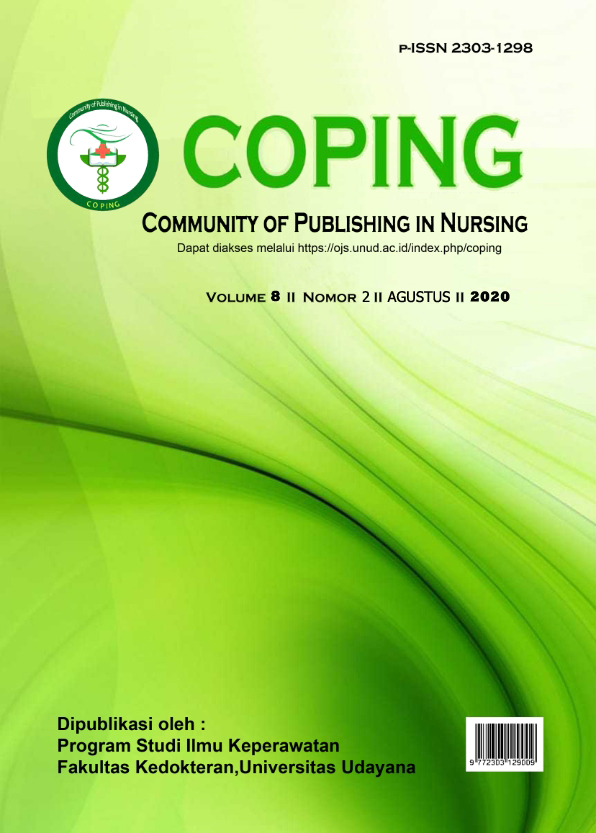SEDENTARY BEHAVIOUR PADA ANAK USIA SEKOLAH DI KECAMATAN DENPASAR TIMUR
Abstract
Obese children are at high risk of becoming obese as adults and have the potential to experience diseases such as cardiovascular disease. Obesity will cause health problems in school-age children, which is around 20-30% of children suffer from hypertension, type 2 diabetes meillitus and sleep apnea. Children will also experience psychosocial disorders such as depression and low self-esteem. One of the causes of obesity in school-age children is sedentary behavior consisting of reading, sitting, and screen-based activity (watching television, playing video games, playing computers and playing smartphones). The results of research in Bali, especially in the city of Denpasar, children above ten years who do the most sedentary behavior is for 6 hours per day and the result is 44.0%. This study aimed to identify sedentary behavior in school age children. This type of research is deskriptive research and used a cohort study. Sample in this study were 122 elementary school children aged 10-12 years. The results obtained that the most sedentary behavior is often carried out by school-age children is screen-based activity especially watching television. Parents are advised to limit the activity of watching television to children and increasing physical activity.
Downloads
References
Atkin A.J., Corder K., Ekelund U., Wijndaele K., Griffin S.J., van Sluijs E.M.F. (2013). Determinants of change in children’s sedentary time. PLoS ONE. doi: 10.1371/journal.pone.0067627.
Centers For Disease Control And Prevention. (2016). Childhood Obesity Causes & Consequence. (Online Diakses Melalui Https://Www.Cdc.Gov/Obesity/Childhood/Causes.Html Pada Tanggal 9 Januari 2018)
Dinas Kesehatan Kota Denpasar. (2016). Rekapitulasi Hasil Penjaringan Kesehatan Peserta Didik Di Wilayah Kerja Seluruh Puskesmas Kota Denpasar. Denpasar.
Fletcher, E. N., Whitaker, R. C., Marino, A. J. & Anderson, S. E. (2014). Screen time at home and school among low-income children attending head start. Child Indicators Research, 7(2), 421-436. doi: 10.1007/s12187-013-9212-8
Hale, L., & Guan, S. (2015). Screen time and sleep among school-aged children and adolescents: A systematic literature review. Sleep Medicine Reviews, 21, 50–58. doi: 10.1016/j.smrv.2014.07.007
Hardy, L., King, L., Espinel, P., Cosgrove, C., & Bauman, A. (2010). NSW schools physical activity and nutrition survey (spans)-full report. N. M. o. health. Sydney: NSW Ministry of Health.
Hoyos, C. I. & Jago, R. (2010). Systematic review of correlates of screen-viewing among young children. Preventive Medicine, 51(1), 3-10. doi: 10.1016/j.ypmed.2010.04.012
Hidding L M., Altenburg T M., Ekris E V., and Chinapaw M J M. (2017) Why Do Children Engage in Sedentary Behavior? Child- and Parent-Perceived Determinants. Int. J. Environ. Res. Public Health 14, 671; doi:10.3390/ijerph1407067
International Telecommunication Union (ITU). (2016). Country ICT data: Mobile-cellular subscription. Diakses melalui https://www.itu.int/en/ITU-D/Statistics/Pages/stat/default.aspx
Jago, R., Salomon-Moore, E., Toumpakari, Z., Lawlor, D. A., Thompson, J. L., & Sebire, S. J. (2018). Parents perspective of change in child physical activity & screen-viewing between Y1 (5-6) & Y4 (8-9) of primary school: Implications for behavior change. BMC Public Health 18, 520. https://doi.org/10.1186/s12889-018-5445-2
Jong E D., Visscher T L., HiraSing R A., Heymans M W., Seidell J C., & Renders C M. (2013). Association between TV viewing, computer use and overweight, determinants and competing activities of screen time in 4- to 13-year-old children. International Journal of Obesity, 37, 47-53
Kementrian Komunikasi dan Informatika Republik Indonesia. (2015). Peta industri game di Indonesia. Direktorat Pemberdayaan Informatika Kementrian Komunikasi dan Informatika.
Larouche, R. (2014). Assessing the health-related outcomes and correlates of active transportation in children and youth. Applied Physiology, Nutrition & Metabolism, 39, 403-403. http://www.nrcresearchpress.com/doi/pdf/10.1139/apnm-2013-0450
Lee, S. T., Wong, J. E., Shanita, S. N., Ismail, M. N., Deurenberg, P. & Poh, B.K. (2015). Daily physical activity and screen time, but not other sedentary activities, are associated with measures of obesity during childhood. International Journal of Environmental Research and Public Health, 12, 146-161.
Minges K E., Chao A M., rwin M L., Owen N., Park C., Whittemore R., Salmon J. (2016). Classroom Standing Desks and Sedentary Behavior: A Systematic Review. PEDIATRICS Volume 137 , number 2
Riset Kesehatan Dasar. (2013). Laporan Hasil Riset Kesehatan Dasar Indonesia. Jakarta: Kementrian Kesehatan R.I.
Salmon J., Tremblay M. S., Marshall, S. J. & Hume, C. (2011). Health risks, correlates and interventions to reduce sedentary behavior in young people. American Journal of Preventive Medicine, 41(2), 197-206. doi: 10.1016/j.amepre.2011.05.001
Sijtsma, A., Koller, M. Sauer, P. J. J & Corpeiljn, E. (2015). Television, Sleep, Outdoor Play Bmi In Young Children: The Gecko Drenthe Cohort. European Journal Of Pediatric, 174(5), 631-9. Doi: 10.1007/S00431-014-2443-Y







